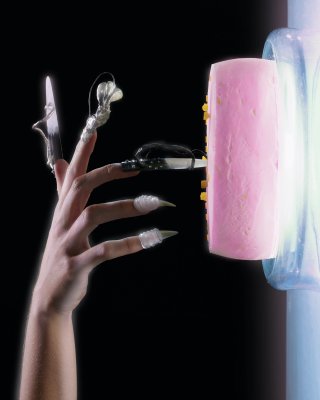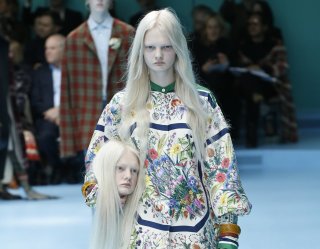Beyond the Aesthetics. Online-Talk mit Dr. Nigel Lezama und Cyshimi
Im Rahmen der Ausstellung NAILGASM. Maniküre, Mode und Gesellschaft luden wir Dr. Nigel Lezama, Außerordentlicher Professor für moderne Sprachen, Literatur und Kultur an der Brock University in Ontario, Kanada, und die in Brasilien arbeitende transdisziplinäre Künstlerin Viviane Lee Hsu/Cyshimi ein, um über den jüngsten Aufschwung der Nail Art im Mainstream zu diskutieren.
27.04.2023, online
Während des Talks befassten wir uns mit der Nail Art als Modedesignpraxis und untersuchten ihre Verbindungen zu Self-Care, Identität und Aktivismus.

Interview
Nigel, last year you wrote a text called « Cardi B’s Nails: The Excess of Gender, Race, and the Commodity »: can you explain to us what led you to write a text about her, and more specifically, her nails?
Dr. Nigel Lezama: It’s a funny story. Back in 2017, after Cardi B’ released her first song “Bodak Yellow,” which I loved, I started to see more and more young women sporting artistic manicures. One of Cardi’s signatures from the beginning of her cultural currency was her artistic manicures. What was really interesting was that Cardi took this practice that was considered “hood” style or street style and paired it with a high-end aesthetic. For example, she would match her nails to her Hermès Birkin bags. After that, I saw a lot of young, white women with these nails, that up until then had been a racialized aesthetic. What I mean is that it was part of a so-called ghetto fabulous or stripper style, that was not really accepted as a practice of “respectability.” But when I was browsing or shopping in expensive department stores, I saw that sales associates and customers had these exceptionally long and decorated nails. It was obvious that something was changing. I wasn’t quite sure if I was witnessing an example of appropriation or of appreciation. So I decided to do a deep dive on manicure culture and see what I could figure out.
Cyshimi, you are a transdisciplinary artist and often use nails as a medium in your artistic practice. You call those nails « performative sculptures ». Could you tell us more about what you mean by that?
Cyshimi: Performative sculptures essentially means that the nail sculpture is not just a static object or an object to contemplate, but it’s actually a sculpture that is part of an alive and expressive body and so the nails bend to the wearer the same way that the wearer bends to the nails. As a nail artist, I mold acrylic to create nails and the acrylic molds me back, it hits and rebounds. Wearing nails and nail sculptures changes the way you deal with the world physically and also in an abstract form, when it changes the way people see you and the way you start seeing yourself. Nails are a representation of your identity and how your body can expand and once you wear these body objects you notice your performance changes too.
You both chose to focus on nails and nail art in your practice. Why do you think the topic of nail art is so visible right now? Why has it become a trend?
Dr. Nigel Lezama: We’ve been in a period of reckoning for several years now during which racialized and marginalized groups are taking up more space in the public sphere. In North America, in particular, but in Europe, Great Britain, and the African continent as well, there’s been a movement to decolonize the cultural institutions and practices that make up dominant society and that were built on a foundation of Eurocentrism and white supremacy. Through this wider, global movement, the stories about how historically marginalized communities express their style and their taste started to circulate to broader audiences. In black popular culture, this meant a reclaiming of door knocker earrings and a reminder that practices like logo-centric fashions and African wax cloth, for example, have been part of the culture long before it became fashionable. And nail art was part of this movement. With the heightened presence of nail art in this particular moment, it gave people from outside the culture the opportunity to try out this style. The fact that it’s a bigger trend now, I think, starts from the examples of black and Latina women, like Cardi B and, more recently, the runner Sha’Carri Richardson, who show us that we can style ourselves and our bodies how we want and right down to our fingertips. We can make ourselves into a work of art. In this way, I see nail art as an example of inspiration and not appropriation. We try out this style and we understand the feeling of expressing ourselves right down to our fingertips and it makes us feel special.
What does self-care mean in regard to nail art? And in which ways does dominant culture limit self-care choices?
Cyshimi: I believe that taking time for artistic practices like fashion, makeup and nails is personally a way to feel connected and present with my body and my physical form. It can be similar to a magic ritual that puts you in an acknowledgment state of who you are. So when I dress up, put makeup on and put my nails, that’s the way that I feel mostly me, myself. And that is self care because when you’re comfortable with what you wear and how you present yourself, you’re comfortable with the mind. I think dominant culture can limit it in many ways, but regarding nails is the way they create a fixed concept in the common sense that nails are tied to vulgarity and dirtiness, the same way that dominant culture is almost always against any subversive style. Or when they attribute anything that is considered feminine like fashion/makeup/nails as something superficial and dumb, wanting to hinder us to express ourselves in alternative ways based on gender bias. Those are the kinds of thinking that I believe we have to change and transform.
Mehr


